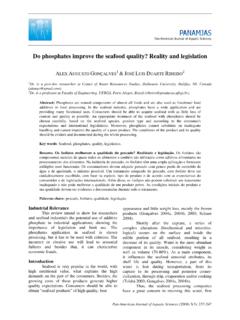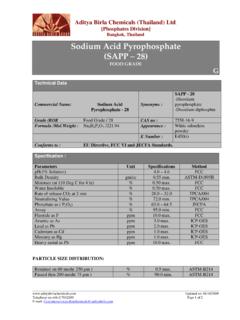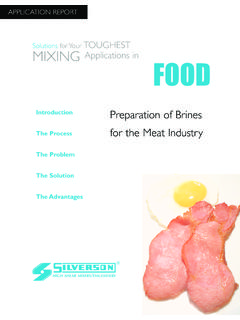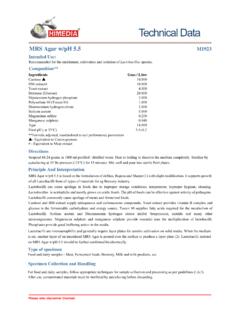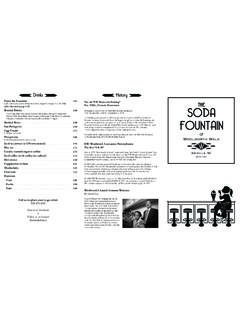Transcription of PROCESSING INSPECTORS' CALCULATIONS …
1 United States Department of AgricultureFood Safety Inspection ServiceAdministrative ManagementHuman Resource Development DivisionPROCESSING INSPECTORS' CALCULATIONS HANDBOOKR evised 1995iiiTABLE OF CONTENTSPageSpecificationsiChapter1 INTRODUCTION1 Overview and Purpose1 Background2 Establishment Responsibilities4 Inspection Responsibilities42 CONVERSION TO PARTS PER MILLION (PPM)63 CURING AGENT (NITRITE AND NITRATE) CALCULATIONS11 Introduction11 Nitrite Used in Cured, Comminuted Products12 Nitrite Used in Cured, Pickled Products19 Nitrite Used in Cured, Dry Products24 Nitrite Used in Bacon27 Nitrate Used in Cured, Comminuted, Pickled, and Dry Products31 Nitrite and Nitrate Used Together in a Single Curing Method32 Nitrite and Nitrate Used Together withMore Than One Curing Method33 4 CURE ACCELERATOR CALCULATIONS34 Introduction34 Cure Accelerator Limits34 Cure Accelerators Used in Cured, Comminuted Products35 Cure Accelerators Used in Cured.
2 Pickled Products36 Replacing Cure Accelerators with Citric Acid or Sodium Citrate37ivTable of ContentsChapterPage5 PHOSPHATE CALCULATIONS38 Introduction38 Phosphate Limits38 Phosphates Used in Comminuted Products39 Phosphates Used in Pickled Products416 BINDER AND EXTENDER CALCULATIONS42 Introduction42 Binder and Extender Limits42 Binders and Extenders Used in Comminuted Meat Products43 Binders Used In Pickle-Cured Meat Products467 FLAVORING CALCULATIONS48 Introduction48 Flavoring Limits48 Flavorings Used in Comminuted Meat Products498 ANTIOXIDANT CALCULATIONS53 Introduction53 Antioxidant Limits53 Antioxidants Individually Added to Meat and Poultry Products54 Antioxidants Added to Meat and Poultry Productsas a Mixture55 Table of ContentsvChapterPage9 MAXIMUM AND MINIMUM MEAT OR POULTRY COMPONENT CALCULATIONS58 How to Determine the Maximum Amount of Beef Cheek MeatAllowed in Ground Beef, Hamburger.
3 And Fabricated Steaks58 Adding Shank Meat to Chopped Ham Products59 How to Determine the Maximum Amount of Poultry Allowedin Cooked Sausage Products61 Meat Requirements in Corned Beef Hash Products62 Meat Requirements in Spaghetti and Meat Balls with Tomato Sauce63 How to Calculate the Fresh Meat Required64 Substituting Cooked Meat for Fresh Meat65 How to Calculate the Required Amount ofMeat or Poultry Roll to Use67 How to Determine the Minimum Meat PFF Percentage69 Protein Fat Free (PFF) Adjusted for Use70 10 PRODUCTS LABELED--"X% WATER" OR"X% OF WEIGHT IS ADDED INGREDIENTS"72 Introduction72 Uncooked Meat Products ContainingAdded Ingredients (Solutions)73 Cooked Meat and Poultry Products, and Specific Cooked and Uncooked Pork Products Containing Added Ingredients (Solutions)
4 7411 PUMP/PICK-UP/GAIN CALCULATIONS76 Introduction76 How to Determine Percent Gain78 How to Determine the Maximum Percent Pump80 How to Determine the Maximum Amount of Gain83 How to Determine the Green Weight When the Pumped/TreatedWeight and Percent Gain are Known83viTable of ContentsChapterPage12 SHRINKAGE CALCULATIONS85 Introduction85 How to Determine a Product's Required Shrink 85 How to Determine Cook and Chill Shrinks8613 YIELD CALCULATIONS88 Introduction88 How to Determine a Product's Yield8814 MISCELLANEOUS CALCULATIONS91 How to Determine the Percent of an Ingredient in a Formula91 How to Determine the Fat Content of a Comminuted Product Formula92 Using the Pearson Square Method to Verify a Product's Fat Content at the Time of Formulation93 How to Determine Brine Concentration96 How to Determine the Compliance of Breaded Product97 How to Determine a Projected or Calculated Finished Weight100 How to Determine the Percent of Proteinaceous Ingredientsin a Cooked Sausage102 How to Determine if a Product Meets the 70/30 Labeling Provision105 How to Determine the Volume of a Container107 APPENDIX109 Converting Units of Measurement109 Symbols114 Solving Equations that Have an Unknown Value115 ABBREVIATIONS AND GLOSSARY124 INDEX1301 Chapter 1 INTRODUCTIONOVERVIEW AND PURPOSEThe
5 Mission of the Food Safety and Inspection Service (FSIS) is to assure that meat, meat food,poultry, and poultry food products distributed in interstate commerce are wholesome, notadulterated, and properly marked, labeled, and packaged. FSIS enforces the Federal MeatInspection Act (FMIA), the Poultry Products Inspection Act (PPIA), and the regulationsimplementing these laws. Documents such as the FSIS Directives, FSIS Notices, and the Meatand Poultry Inspection (MPI) Manual provide inspection personnel with specific instructions andpolicies to help them enforce the laws and regulations. Whether meat and poultry products are in compliance with the laws and regulations is oftendetermined by how the products are formulated and processed.
6 Careful attention to the kind andamount of ingredients, their conditions of use, and the standards of product identity andcomposition are necessary to assure compliance. The meat and poultry inspection regulations provide specific information on the permittedamounts and uses of various substances that are allowed to be used in meat and poultry products. These substances must not be used in a manner that would deceive the consumer by concealingspoilage or inferiority, or by causing the products to appear of a different size, weight, or qualitythan they actually regulations and policy memorandums also prescribe definitions and standards of identity, orcomposition, for certain meat and poultry products.
7 Standards of identity set specificrequirements for a product's make-up. For instance, these standards may specify the kind andamount of meat or poultry, the maximum amount of non-meat and non-poultry ingredients, andany other ingredients allowed, or expected, in the final product. Meat and poultry productstandards are established to assure that consumer expectations are met for a product that islabeled with a certain name. Additional policies have been established to guide inspectionpersonnel in determining whether products are being prepared in accordance with the laws inspectors carry out monitoring activities, including checks on product preparation, toassure that official establishments are maintaining control of their processes.
8 Among themonitoring activities are food ingredient CALCULATIONS , which are intended to help ensure that meatand poultry products are not adulterated or misbranded. From time to time, questions have beenraised, and criticisms voiced, about the accuracy, reliability, and consistency of FSIS calculation2methods. In some cases, the questions and criticisms--by field personnel, label reviewers,headquarters staff, and industry personnel--have resulted from the fact that different terminologywas used in the regulations that were written and promulgated at different times. Of course, themeat and poultry industry has changed over the years, and the regulations have been updated toaccommodate new products and processes.
9 But whatever the reason for the inconsistencies, ifthey appear to impair the Agency's ability to administer the meat and poultry inspection programnationally in a uniform and equitable way, they must be reduced, explained, or editions of the PROCESSING Inspectors' CALCULATIONS Handbook have amounted to littlemore than grab bags of sample CALCULATIONS , formulae, and definitions to help inspectors ofprocessed foods in their work. This new edition is more thematic and has a threefold purpose. First, it is an expanded collection of sample calculation methods. Second, it identifies in a singledocument the various regulatory limitations on the use of restricted ingredients ( , cure agents,cure accelerators, binders and extenders, phosphates, antioxidants, and flavorings) in meat andpoultry products, and illustrates the calculation method or methods for each specific ingredient.
10 Third, it standardizes the interpretation of the regulations for calculation purposes and establishesconsistent calculation methods for inspection and establishment personnel. While the Handbook may refer to or reiterate Agency policy, it is not intended to replace it. TheHandbook is intended primarily as a reference or aid to learning how to perform variouscalculations. It should also help provide insight into the reason why a given policy is needed andits relative importance in a science-based food safety program. The Handbook is divided into chapters which cover specific subjects and calculation types. Several chapters have been broken down into subject matter sections that have an introduction, aformula (if applicable) and at least one procedure table.


